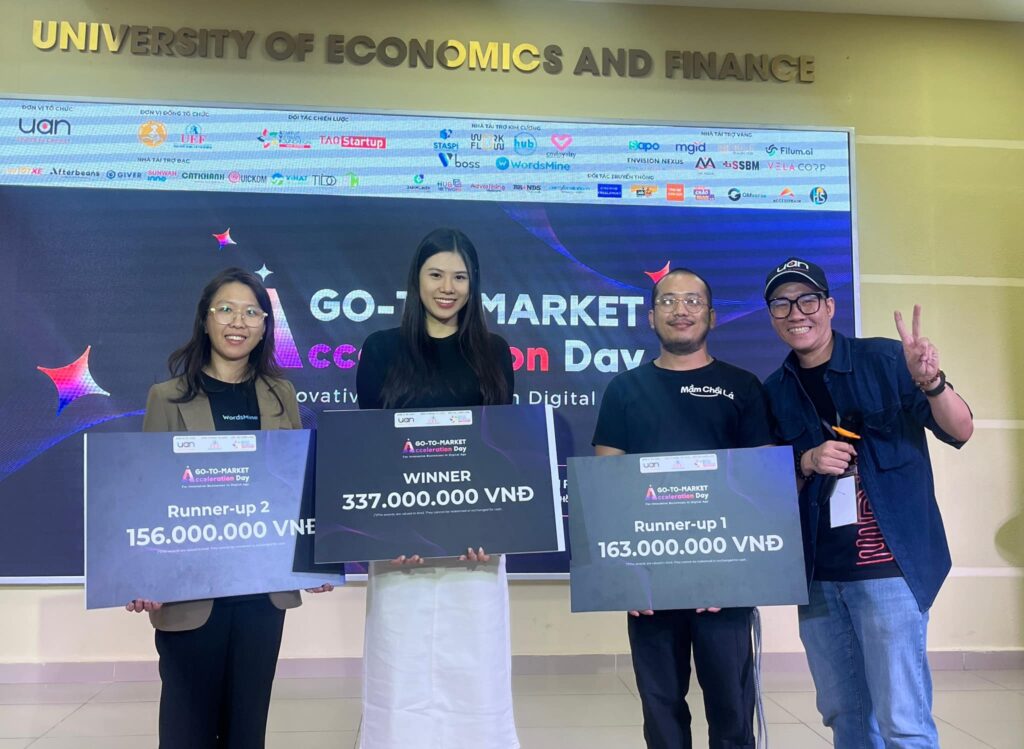Gamification in marketing is the act of using interactive minigames with elements such as point scoring, challenging objectives, competing, leaderboard and rewards for marketing campaigns. Brands can implement gamification strategies for leveraging brand engagement, boosting sales and revenue, gaining positive brand’s impression, nurturing customers’ loyalty, collecting customers’ data and so on.
But how can gamification actually be implemented in a real marketing scenario? And which kind of campaigns can be most utilized with minigames? Let’s find out in this article.
-
Reward-based promotions
Have your businesses ever fallen into a difficult situation in which your revenue looks almost gloomy? You have tried promotion campaigns but still didn’t gain much traction for your brand or products? This is when you need to liven up your campaign with minigames.
There are more and more brands and products entering the market nowadays. Therefore, the most important thing is making your businesses truly distinguished from the others’. Implementing gamification in marketing campaigns is one of the best strategies to achieve that.

How to boost your revenue?
The main goals for this type of marketing campaign are to boost sales or revenue, build brand loyalty, improve customer retention or expand market reach. An easy-to-win and non-competitive game fitting for distributing vouchers, coupons or products will be ideal for your business.
The basic strategy is launching promotion campaigns on special occasions: big holidays, Black Fridays or even brand’s anniversaries. You can start developing a minigame suitable for rewards distribution (e-coupons, e-voucher or products), building a list of rewards used for the game and then deploying the game on your brand’s social platforms.
For the minigames, there are a wide range of gameplays to pick, but one of the most utilized game mechanics is fortune games. Fortune games are games that are based on lucky elements and random rewards with simple and straightforward gameplay. In fact, you may have seen this type of game often in your daily life: lucky wheel, crane game, mystery boxes, etc. Those games easily capture people’s attention and invite new customers to try.

Example of lucky wheel game
Or you can apply more engaging gameplay with actual challenging and scoring mechanics for a more flexible way of rewards distribution. Just make sure that the game is not too hard for anyone to play!
Case study: PNJ campaign “Challenge of Fortune”
PNJ, a jewelry manufacturer and retailer brand in Vietnam, implemented a significant gamification program “Lắc Tài Lộc” or “Challenge of Fortune” as a part of their bigger campaign in the 2023 Lunar New Year. The gamification campaign was set up for two approaches: at PNJ’s stores and through PNJ’s social media platforms.
Customers who had made an online purchase or bought any products at PNJ’s store all received chances to play the game “Challenge of Fortune” to win valuable prizes. For customers who went to retail stores, they were instructed to access the minigame with their smartphones and for online customers, they could go to the website: https://thantai.pnj.com.vn.
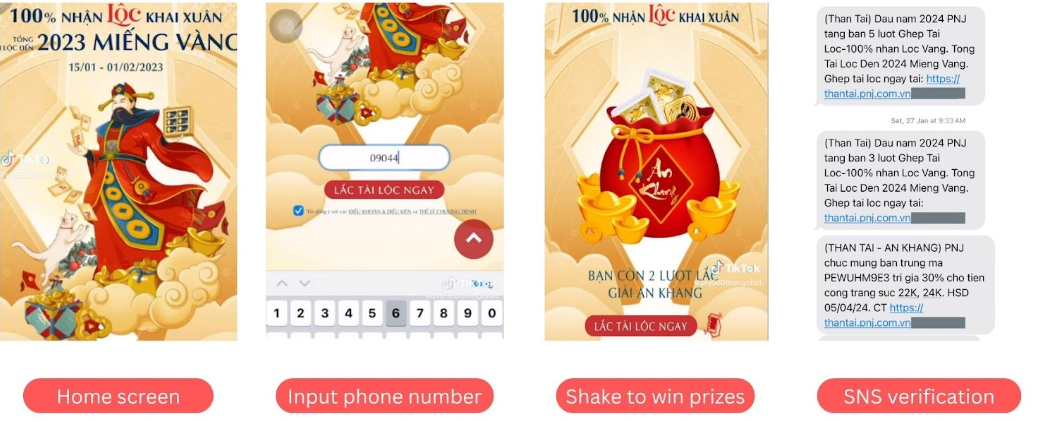
Screenshot of the game
How they set up the game:
- Step 1: Customers access the game by going to the website: https://thantai.pnj.com.vn.
- Step 2: Customers provide phone number to play the game.
- Step 3: Customers shake the phone to generate randomized prizes.
- Step 4: If customers has won a prize, the prize’s code and information will be sent to customers’ provided number.
PNJ set two main goals for this campaign: business goal and social goal. The business goal focused on sales boosting on the occasion of 2023 Tet Holiday and the social goal prioritized brand interaction and customers’ love for the brand. They targeted audiences that were over 25 years old who had a demand for gold jewelry on Tet occasion. The company then actively promoted the campaign on social media platforms.
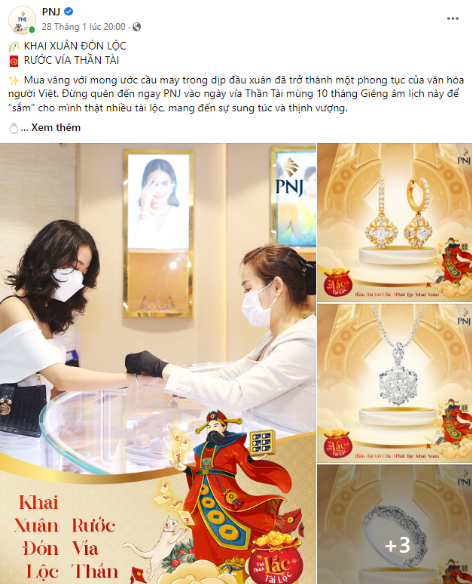
The program attracted over 1,000,000 participants during the campaign’s period and earned over 16 million USD in revenue in January, 2023. PNJ also gained a significant number of interactions on their official Facebook page.
There are more compelling gameplays you can apply to this kind of campaign. Find out more recommendations here.
-
Online competition
Now, your business is doing somewhat fine, but isn’t it a little too quiet these days? You haven’t gained many new customers and your established customers are demanding something more. It is the time to kick off an online competition for everyone to turn their gaze on your brands.
Online competition brings significant benefits to brands: leveraging brand engagement, enhancing user experience, creating leads and CTAs. You can enhance those advantages even more by implementing gamification into the competition. Gamification in marketing campaigns will gather shared experience that captures the attention of your audiences and makes them talk about it, kick off their competitiveness for them to come back to it again and again. That will be a great way to create buzz for your brand.

Online competition is a great way to foster brand engagement
For this type of marketing campaign, the game mechanics and concept will be the crucial points. The gameplay has to be compelling and challenging enough to attract players, but not too hard for everyone to be able to experience. The images, theme colors, characters and assets in the game must align with your brand’s image for a better association between customers and brands. The customers will go through a journey from start to end of the game. With brand’s images weaving into the players’ journey, they will recognize and recall the brand quickly as well as forming a positive impression of the brand.
Case study: Cowan – “Drum to Prosperity

Cowan, an international brand design agency, just released an online minigame to kick off 2024 Lunar New Year. The gameplay is simple, within 16 seconds, the faster players tap the drum, the more coins they will earn. The top players who accumulate the most coins will be honored on the game’s final leaderboard. Players can join the game by following these step:
- Step 1: Go to the game website
- Step 2: Tap the drum as fast as possible to earn coin
- Step 3: Provide your name
- Step 4: Top winners’ scores will be showcased on the game leaderboard

The game brought a wonderful atmosphere for Cowan’s customers, especially Asian customers who celebrated Lunar New Year. The social post had gained great traffic for Cowan’s social media platforms as well as promotion for the company.
You can find similar games to Drum to Prosperity here.
-
Announce & Call-to-action
What if you want to announce a new product, or just simply convey a meaningful story for your brand? Do you still need to develop a game? The answer is yes! Gamification is also a great way to make an announcement compared to the traditional ones. Publishing a game to spread information about a new product or an upcoming event can help gather curiosity from potential customers and create leads for your brand.
For this purpose, like online competition, you should focus on providing an enjoyable gameplay and impressive images to capture the customers’ interest. You should also pay attention to the customers’ playing process: the game has to be easy to access, doesn’t require too much information from the customers or takes too many steps before customers can actually experience the game.

Implement CTA buttons will bring valuable benefits for brands
A Call-to-action button after customers clearing the game can bring great value to your brand, as it will take advantage of the customers’ interest to encourage them to click on the CTA button. It can be a link to your brand’s websites, social platforms or anywhere that could benefit your brand.
Case study:
“Cau Tre Food” is an established Vietnamese brand, founded in 1983, with a 40-year history of development. The brand specializes in producing instant foods such as fried rice, pho, bun, noodles, and various spices. When the brand was promoting the new instant fried rice products, they implemented a gamification campaign with the name “Match correctly, win ultimate Fried Rice”.
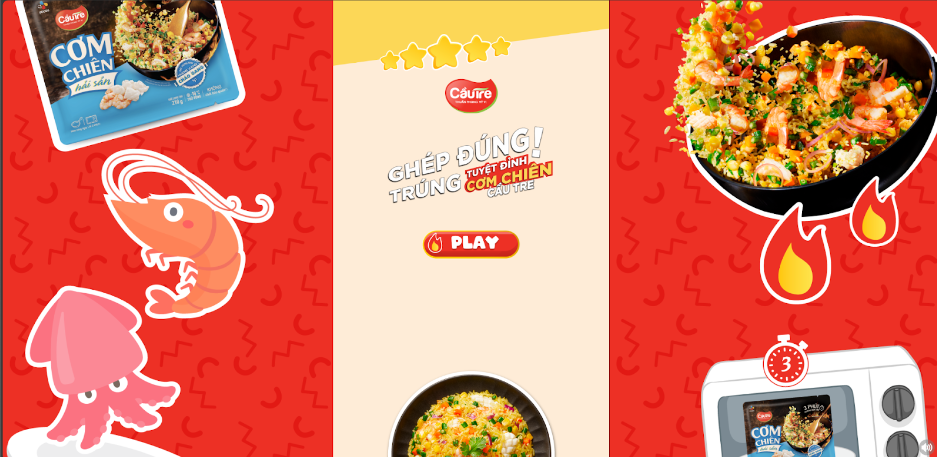
The game used images of the ingredients in the fried rice such as shrimps, squids, carrots and their product’s packages to help customers feel familiar with these new products. The players had to match each ingredient with the right product. When completed, the fried rice would be put in the oven, showcasing a mouth-watering meal afterward.
The game didn’t require too much steps to play, players just needed to do three steps:
- Step 1: Access to the game’s website and login with users’ information
- Step 2: Simply click “Play now” button
- Step 3: Match the ingredients to score points
Not only they announced new products, Cau Tre Food had various rewards for customers who had played the game and shared the results on social media. This movement had gain quite a number of interactions for Cau Tre Food’s Facebook page as well as a boost for their new products.
Find out about how to create your own gamification announcement here.
-
Event Cheer Up
If you are planning an offline event for your business, how about considering utilizing minigames here as well? By integrating gamification in marketing events, brands or companies can foster a lively and interactive environment that brings social interactions, unforgettable experiences, and a sense of camaraderie among participants. For a long time in reality, there have already been many activities that use minigames to liven up the mood of the crowd. Now on a bigger scale such as a live event, minigames can further enhance customers’ excitement.
Depending on the event’s goals and objectives, you can utilize several types of game, even combine various games for each section of the event. Sprinkle some eye-catching rewards into it and you will create a buzz among the attendees in no time!
Case study: Coca-Cola “Cyber Battle” Exhibition
The Coca-Cola “Cyber Battle” exhibition was a marketing campaign that combined interactive gamification experiences with brand engagement. This campaign executed a two-part game strategy at their booth. The first game, a drop game, was designed to grab the attention of exhibition visitors. In this game, players needed to catch falling objects while avoiding obstacles like sugar cubes.
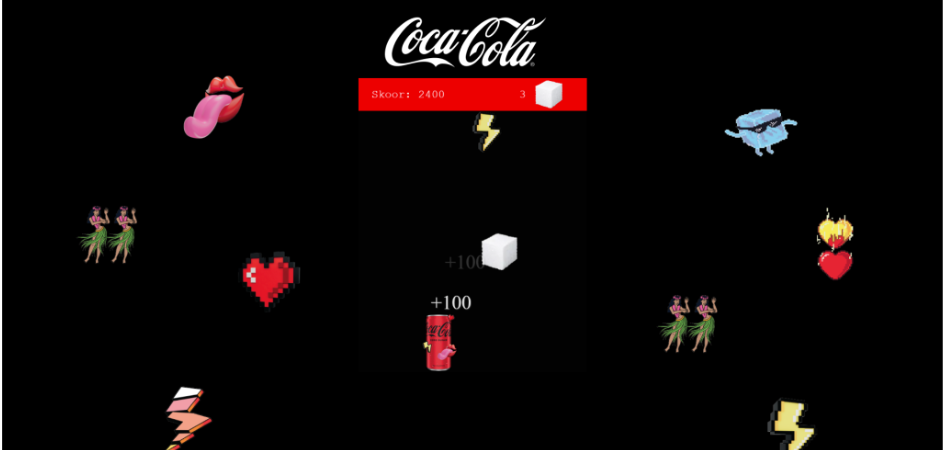
Following this, participants were directed to a wheel of fortune game, where they could spin a wheel to win various beverage prizes. The games featured bright colors and attractive graphics, making them visually appealing and noticeable from a distance. Moreover, both games were projected onto a large LED screen so that everyone could watch as others played.
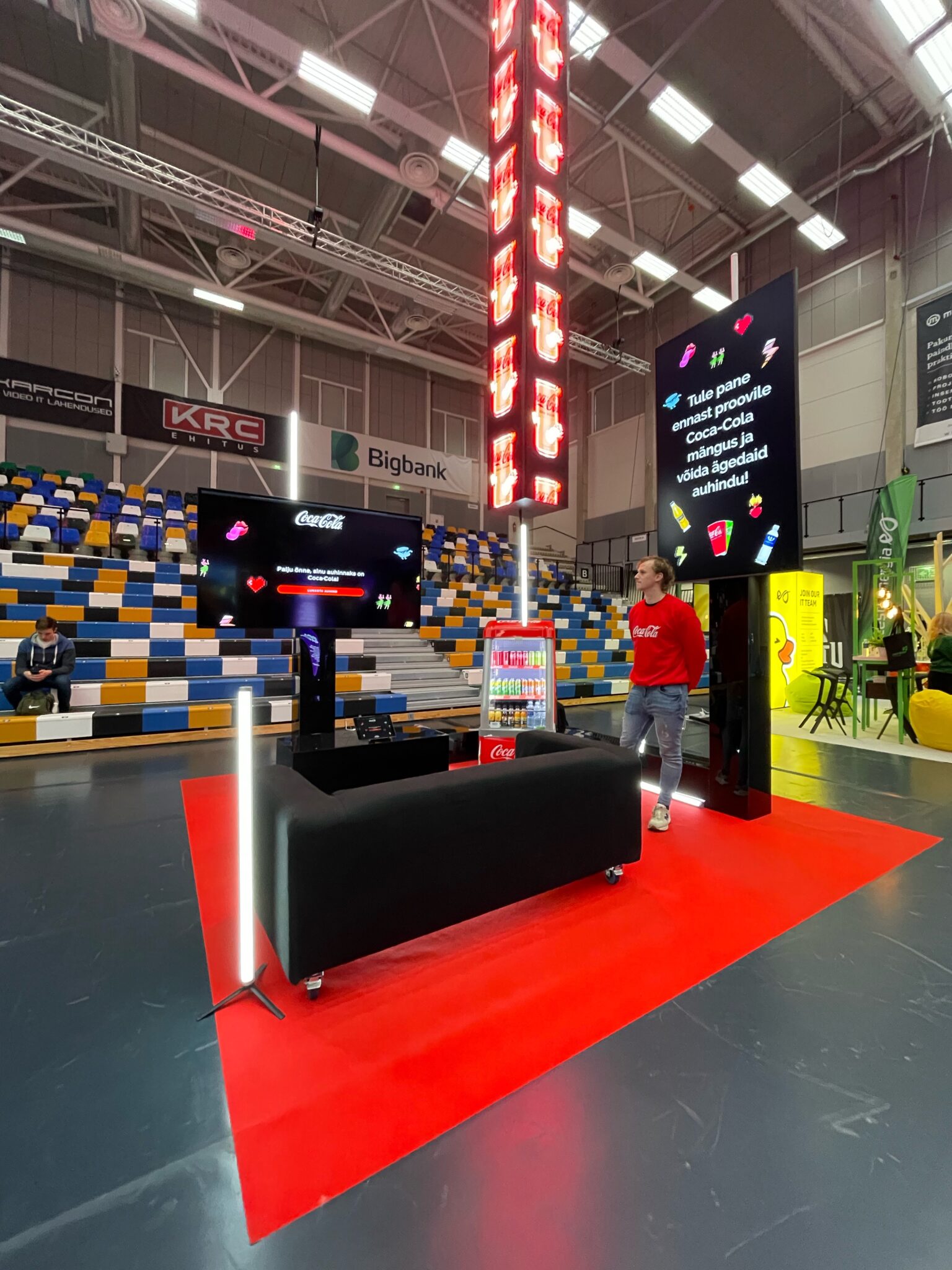
This blend of vibrant visuals, engaging audio cues, and live human interaction created a fully immersive experience that kept visitors engaged for extended periods. Over the 7-hour exhibition, the approach proved highly successful, with over 200 gameplays recorded, demonstrating the strategy’s effectiveness.
Conclusion
Above are some of the strategies to implement gamification in marketing campaigns. However, please note that a gamification campaign requires brands to significantly invest to develop an actual game. Moreover, brands usually have to work with a third-party game agency or build an in-house development team for games, and it indeed will cost a huge amount of time and resources for brands.
So is there a better solution for this? Here we introduce Octokit, an innovative and economical solution for your businesses! Octokit is the world’s first text-to-game artificial intelligence (AI) platform that helps create a mini-game on demand with just simple commands.
It is also a mini-game/AR filter online design tool that requires no programming skills, providing a quick and effective gamification marketing deployment system for marketers and businesses.
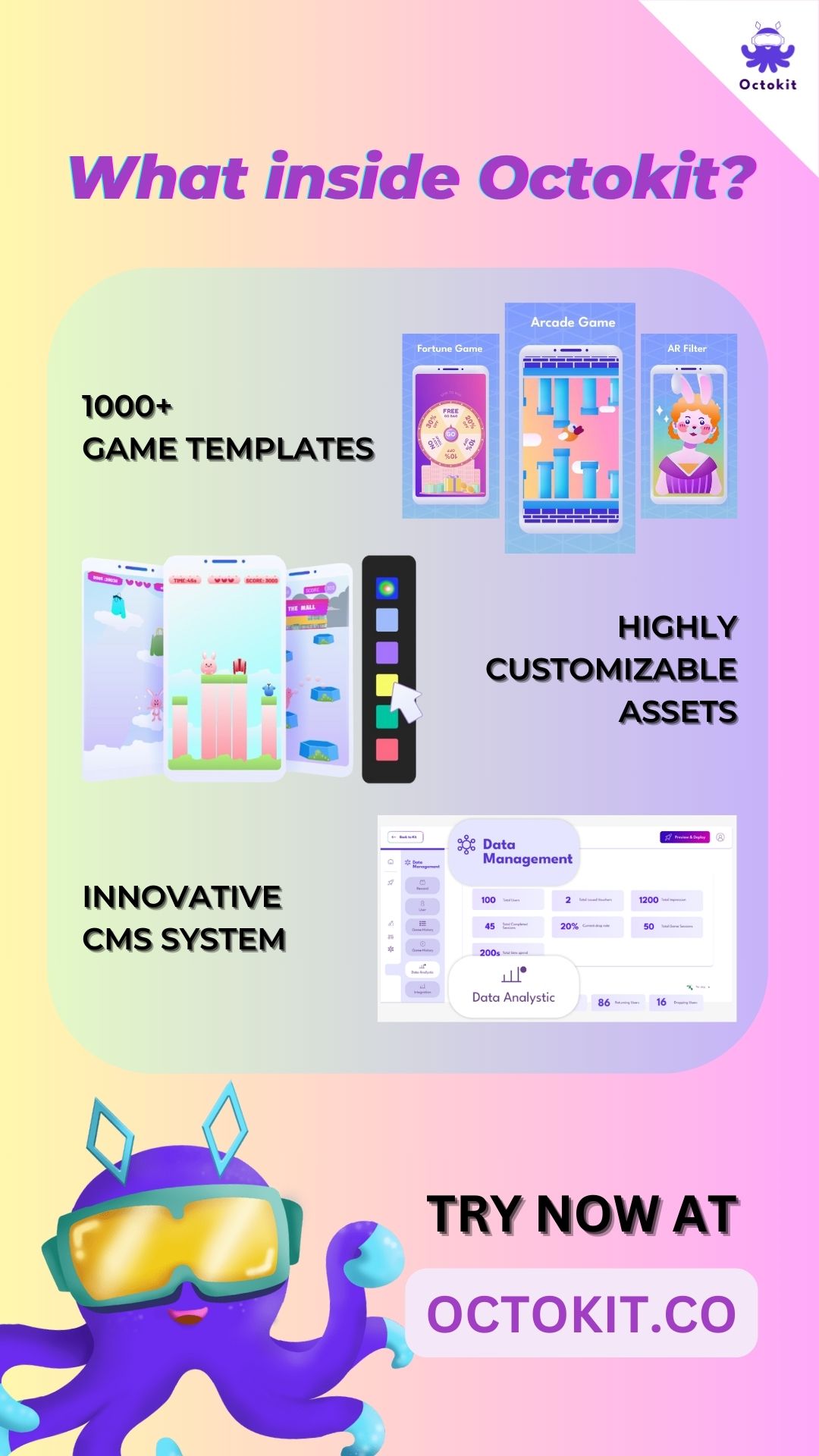
Learn more about Octokit here.


